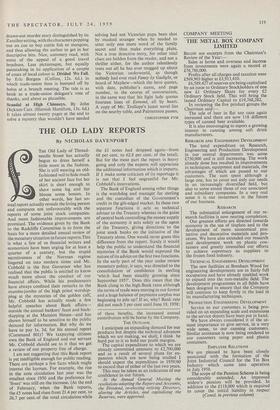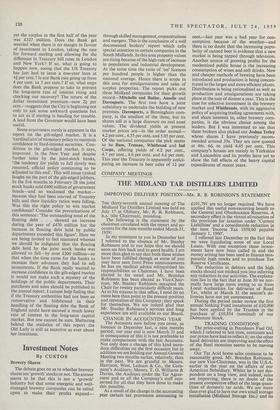THE OLD LADY REPORTS
By NICHOLAS DAVENPORT THE Old Lady of Thread- needle Street has actually begun to dress herself a little more in the fashion. She is still wearing an old- fashioned veil to hide much of her ancient face but her skirt is short enough to show some leg and her blouse some bosom. In - other words, her last an- nual report actually reveals the living person and compares not unfavourably with the reports of some joint stock companies. And more fashionable improvements are promised. The evidence given by the Bank to the Radcliffe Committee is to form the basis for a more detailed annual review of the monetary situation in future reports.This is what a few of us financial writers and economists have been urging for at least a quarter of a century, but the stupid secretiveness of the Norman regime lingered on into modern times and Mr. Cobbold is the first Governor who has realised that the public is entitled to know much more about the conduct of our financial affairs. While his predecessors have always confined their remarks to the mumbo-jumbo of the high priest worship- ping at the mysteries of the golden calf, Mr. Cobbold has actually made a few helpful speeches about Bank affairs— outside the annual bankers' feast and back- slapping at the Mansion House—and has shown himself to be sensitive to the public demand for information. But why do we have to pay Is. 3d. for his annual report (Command 801)? We taxpaying citizens own the Bank of England and our servant Mr. Cobbold should see to it that we get a review of our property free of charge.
I am not suggesting that this Bank report is yet intelligible enough for public reading. There are perhaps a few facts which might interest the layman. For example, the rise in the note circulation last year was the smallest since 1950 and the preference for 'fivers' was still on the increase. (At the end of February, when the Bank reports, the £5 notes had risen from 21.4 per cent. to 26.7 per cent, of the total circulation while the £1 notes had dropped again—from 68 per cent. to 62.8 per cent, of the total). But for the most part the report is heavy going and only the experts will appreciate the additional information which it imparts. If I make some criticism of its reportage it is not that I feel ungrateful for Mr. Cobbold's innovations.
The Bank of England among other things is the watchdog and manager for sterling and the custodian of the Government's credit in the gilt-edged market. In these two separate functions it acts as technical adviser to the Treasury whereas in the guise of central bank controlling the money supply of the economy it acts solely as the agent of the Treasury, giving directions to the joint stock banks on the initiative of the Treasury alone. One would never guess this difference from the report. Surely it would help the public to understand the financial mysteries if the Bank would expound the nature of its advice on the first two functions. In the early part of the year under review monetary policy, it says, was directed to the consolidation of confidence in sterling 'which had been steadily growing since September 1957'. Does this mean that the Bank clung to the high Bank rates although the terms of trade were moving in our favour and a huge balance of payments surplus was beginning to pile up? If so, why? Bank rate did not reach 5 per cent until June 19, 1958: yet the surplus in the first half of the year was £327 million. Does the Bank get worried when there is no margin in favour of investment in London, taking the rate for forward sterling and allowing for the difference in Treasury bill rates in London and New York? If so, what is going to happen now, seeing that the US Treasury has just had to issue a one-year loan at elf per cent.? Is our Bank rate going up from 4 per cent. to 5 per cent.? If so, what steps does the Bank propose to take to prevent the long-term rate of interest rising and checking our recovery? The return of the dollar investment premium—now 21 per cent.—suggests that the City is beginning not only to ask some awkward questions but to act as if sterling is heading for trouble. A lead from the Governor would have been useful.
Some evasiveness surely is apparent in the report on the gilt-edged market. It is a 'cardinal a im'of monetary policy to maintain confidence in fixed-interest securities. Con- ditions in the gilt-edged market, it says, improved in the New Year and despite further sales by the joint-stock banks, 'the tendency for yields to fall slowly was resumed, official policy continuing to be adjusted to this end'. This will rouse cynical laughs on the part of the gilt-edged jobbers. In the five months to February 28 the joint stock banks sold £400 million of government bonds—and so weakened the market— because they had been starved of Treasury bills and their liquidity ratios were falling. Was this the right policy to win market confidence? Consider the prevarications of this sentence: 'The outstanding total of the floating debt . . . showed an increase during the year of £470 million but the increase in floating debt held by public departments exceeded this figure'. Here we are being invited to feel reassured whereas we should be indignant that the floating debt held by the joint stock banks was allowed to fall—by over £200 million—so that when the time came for the banks to increase their advances they had to sell investments. If the Bank really wanted to increase confidence in the gilt-edged market it would not make such a mystery of the holdings of the public departments. Their purchases and sales should be published in the annual report. I cannot help feeling that if the Treasury authorities had not been so conservative and hidebound in their handling of the floating debt the Bank of England could have secured a much lower rate of interest in the long-term capital market. But one cannot be sure. Sheltering behind the statistics of this report the Old Lady is still as secretive as ever about her intentions.







































 Previous page
Previous page